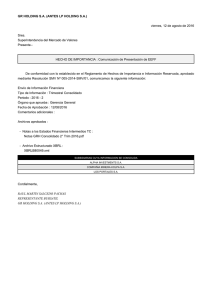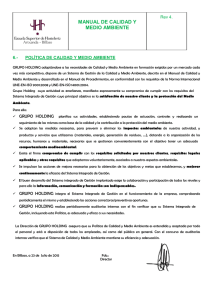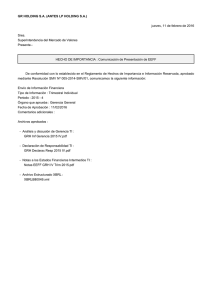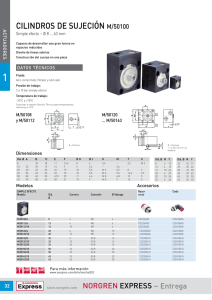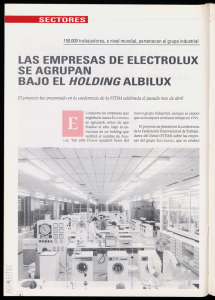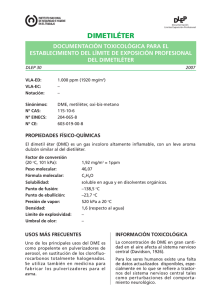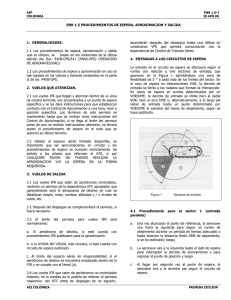ENR 1.5.fm - Aerocivil
Anuncio
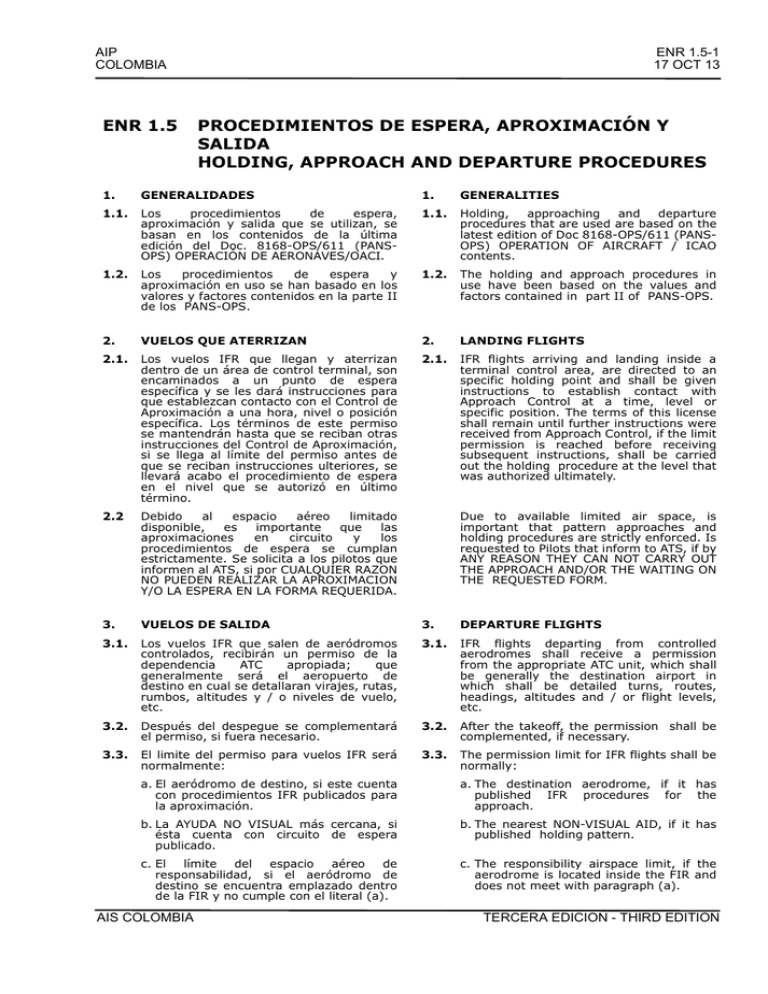
AIP COLOMBIA ENR 1.5 ENR 1.5-1 17 OCT 13 PROCEDIMIENTOS DE ESPERA, APROXIMACIÓN Y SALIDA HOLDING, APPROACH AND DEPARTURE PROCEDURES 1. GENERALIDADES 1. GENERALITIES 1.1. Los procedimientos de espera, aproximación y salida que se utilizan, se basan en los contenidos de la última edición del Doc. 8168-OPS/611 (PANSOPS) OPERACIÓN DE AERONAVES/OACI. 1.1. Holding, approaching and departure procedures that are used are based on the latest edition of Doc 8168-OPS/611 (PANSOPS) OPERATION OF AIRCRAFT / ICAO contents. 1.2. Los procedimientos de espera y aproximación en uso se han basado en los valores y factores contenidos en la parte II de los PANS-OPS. 1.2. The holding and approach procedures in use have been based on the values and factors contained in part II of PANS-OPS. 2. VUELOS QUE ATERRIZAN 2. LANDING FLIGHTS 2.1. Los vuelos IFR que llegan y aterrizan dentro de un área de control terminal, son encaminados a un punto de espera específica y se les dará instrucciones para que establezcan contacto con el Control de Aproximación a una hora, nivel o posición específica. Los términos de este permiso se mantendrán hasta que se reciban otras instrucciones del Control de Aproximación, si se llega al límite del permiso antes de que se reciban instrucciones ulteriores, se llevará acabo el procedimiento de espera en el nivel que se autorizó en último término. 2.1. IFR flights arriving and landing inside a terminal control area, are directed to an specific holding point and shall be given instructions to establish contact with Approach Control at a time, level or specific position. The terms of this license shall remain until further instructions were received from Approach Control, if the limit permission is reached before receiving subsequent instructions, shall be carried out the holding procedure at the level that was authorized ultimately. 2.2 Debido al espacio aéreo limitado disponible, es importante que las aproximaciones en circuito y los procedimientos de espera se cumplan estrictamente. Se solicita a los pilotos que informen al ATS, si por CUALQUIER RAZON NO PUEDEN REALIZAR LA APROXIMACION Y/O LA ESPERA EN LA FORMA REQUERIDA. Due to available limited air space, is important that pattern approaches and holding procedures are strictly enforced. Is requested to Pilots that inform to ATS, if by ANY REASON THEY CAN NOT CARRY OUT THE APPROACH AND/OR THE WAITING ON THE REQUESTED FORM. 3. VUELOS DE SALIDA 3. DEPARTURE FLIGHTS 3.1. Los vuelos IFR que salen de aeródromos controlados, recibirán un permiso de la dependencia ATC apropiada; que generalmente será el aeropuerto de destino en cual se detallaran virajes, rutas, rumbos, altitudes y / o niveles de vuelo, etc. 3.1. IFR flights departing from controlled aerodromes shall receive a permission from the appropriate ATC unit, which shall be generally the destination airport in which shall be detailed turns, routes, headings, altitudes and / or flight levels, etc. 3.2. Después del despegue se complementará el permiso, si fuera necesario. 3.2. After the takeoff, the permission shall be complemented, if necessary. 3.3. El limite del permiso para vuelos IFR será normalmente: 3.3. The permission limit for IFR flights shall be normally: a. El aeródromo de destino, si este cuenta con procedimientos IFR publicados para la aproximación. a. The destination aerodrome, if it has published IFR procedures for the approach. b. La AYUDA NO VISUAL más cercana, si ésta cuenta con circuito de espera publicado. b. The nearest NON-VISUAL AID, if it has published holding pattern. c. El límite del espacio aéreo de responsabilidad, si el aeródromo de destino se encuentra emplazado dentro de la FIR y no cumple con el literal (a). c. The responsibility airspace limit, if the aerodrome is located inside the FIR and does not meet with paragraph (a). AIS COLOMBIA TERCERA EDICION - THIRD EDITION ENR 1.5-2 17 OCT 13 AIP COLOMBIA 3.4. Los vuelos IFR que salen de aeródromos no controlados tratarán, en la medida de lo posible, de obtener el permiso respectivo del ATC antes de despegar; de no lograrlo, ascenderán después del despegue hasta una altitud en condiciones VFR que permita comunicación con la dependencia de Control de Tránsito Aéreo. 3.4. IFR flights departing from non-controlled aerodromes shall try, as far as possible, to obtain the respective permission from ATC before the takeoff; If not achieving shall ascent after the takeoff to an altitude in VFR conditions that allows communication with the Air Traffic Control unit. 4. ENTRADAS ESPERA 4. ARRIVAL TO THE HOLDING PATTERNS A LOS CIRCUITOS DE The arrival into the holding pattern shall be carried out according to the course related to three arrival areas, shown in Figure 1 by assuming a flexible 5 ° zone on each side of the sector limits. In the event of holding at VOR intersections , the arrival track is limited to the radial that forms the intersection. In the event of holding at certain points by a VOR / DME, the arrival track is limited to VOR radial, or the DME arc, or alternatively, along the arrival radial until a point determined by VOR / DME at the end of the withdrawal length as it is published. La entrada en el circuito de espera se efectuará según el rumbo con relación a tres sectores de entrada, que aparecen en la Figura 1 admitiéndose una zona de flexibilidad de 5 ° a cada lado de los límites del sector. En el caso de espera en intersecciones VOR, la derrota de entrada se limita a los radiales que forman la intersección. En casos de espera en puntos determinados por un VOR/DME, la derrota de entrada se limita bien al radial VOR, bien al arco DME o, alternativamente, a lo largo del radial de entrada hasta un punto determinado por VOR/DME al extremo del tramo de alejamiento, según se haya publicado. Figura 1 / Figure 1 4.1. Procedimiento para (entrada paralela) el sector 1 4.1. Sector 1 procedure (parallel arrival) Una vez alcanzado el punto de referencia, la aeronave vira hacia la izquierda para seguir un rumbo de alejamiento durante un periodo de tiempo adecuado o hasta alcanzar la distancia límite DME de alejamiento, si se ha publicado; luego, a. Once is reached the waypoint, the aircraft turns to the left in order to follow a outbound heading during a suitable period of time or until the DME outbound limit distance is reached, if published; then, b. La aeronave vira a la izquierda hasta el lado de espera para interceptar la derrota de acercamiento o para regresar al punto de posición y luego b. The aircraft turns to the left to the holding side to intercept the inbound track or return to the position point and then c. Al llegar por segunda vez al punto de espera, la aeronave vira a la derecha para seguir el circuito de espera. c. Arriving for second time to the holding point, the aircraft turns to the right to follow the holding pattern. d. TERCERA EDICION - THIRD EDITION AIS COLOMBIA AIP COLOMBIA 4.2. 4.3. Procedimiento para (entrada desplazada) ENR 1.5-3 17 OCT 13 el sector 2 4.2. a. Una vez alcanzado el punto de referencia, la aeronave vira para seguir una derrota que forme un ángulo de 30 grados con el sentido contrario a la derrota de acercamiento en el sector de espera; luego a. Once the waypoint is reached, the aircraft turns to follow a track at a 30 degrees angle counterclockwise to the inbound track in the holding sector; then b. La aeronave se alejará: b. The aircraft shall go away: > Durante un periodo de tiempo adecuado, cuando se especifique cronometraje, o > For a suitable period of time, when timing is specified, or > Hasta que se alcance la distancia límite DME adecuada, cuando se especifique distancia, o > Until the proper DME distance limit is reached, when distance is specified, or > Cuando se especifique también un radial delimitador, bien hasta que se alcance la distancia límite DME, o hasta que se encuentre el radial delimitador, de ambos eventos, el primero; luego, > When a delimitation radial(road) is also specified , until the DME distance limit is reached, or until the delimitation radial(road) is localized, of both events, the first one; then, c. La aeronave vira hacia la derecha para interceptar la derrota de espera acercándose; luego c. The aircraft turns to the right to intercept the approaching holding track, then d. Después de haber llegado por segunda vez, al punto de referencia de espera, la aeronave vira hacia la derecha para seguir el circuito de espera. d. Having arrived for second time, to the reference holding point, the aircraft turns to the right to follow the holding pattern. Procedimiento para (entrada directa) el sector 3 4.3. Después de haber llegado al punto de referencia, la aeronave vira hacia la derecha para seguir el circuito de espera. 4.4. Entrada el arco DME Procedimiento de entrada para la espera VOR/DME 4.4. especial Si se especifica un punto de referencia secundario al extremo del tramo de alejamiento de un circuito de espera VOR/DME (Figuras 2 y 3), no se autoriza la entrada por los sectores 1 y 2. Se entrará directamente al circuito de espera utilizando el radial de entrada publicado o el procedimiento de entrada por el sector 3. Al llegar al punto de referencia, la aeronave virará hacia la derecha para seguir el circuito de espera. AIS COLOMBIA Sector 3 procedure (direct arrival) Having arrived to the reference point, the aircraft turns to the right to follow the holding pattern. Después de haber llegado al punto de referencia, la aeronave entrará al circuito de espera de acuerdo, bien según el procedimiento de entrada por el sector 1, o por el sector 3. 4.5. Sector 2 procedure (displaced arrival) Arrival to the DME arc Having arrived to the reference point, the aircraft shall enter to the holding pattern accorded by the arrival procedure to the sector 1, or sector 3. 4.5. Special arrival procedure to the VOR/ DME holding point If a secondary reference point is specified to the top of the outbound leg of a VOR / DME holding pattern (Figures 2 and 3) the arrival for the sectors 1 and 2 is not allowed. Shall goes straightly to the holding pattern using the radial arrival published or the arrival procedure for sector 3. At the point of reference, the aircraft shall turn right to follow the holding pattern. TERCERA EDICION - THIRD EDITION ENR 1.5-4 17 OCT 13 AIP COLOMBIA ESPERA VOR/DME HACIA LA ESTACIÓN/ VOR/DME HOLDING TO THE STATION ESPERA VOR/DME ALEJÁNDOSE DE LA ESTACIÓN/ VOR/DME HOLDING MOVING AWAY FROM STATION Figura 2 / Figure 2 Figura 3 / Figure 3 Entrando a un punto VOR/DME en el tramo de alejamiento apuntando hacia la posición de espera./ Going into a VOR/DME point on the outbound leg pointing toward the holding position. Entrada a un punto VOR/DME en el tramo de alejamiento, alejándose de la posición de espera./ Arrival to a VOR/DME point moving away from the holding position. 4.6. Tiempo/distancia de alejamiento 4.6. Time / withdrawal length With calm wind, time you fly with outbound heading should not exceed one minute if it is at 4.250 m (14.000 ft) or below, and a minute and a half if you are above 4.250 m (14.000 ft). When DME is available, can be specified, depending on the distance, the distance length instead of expressing in time. Con aire en calma, el tiempo que se vuele con rumbo de alejamiento no debería exceder de un minuto si se está a 4.250 m (14.000 ft), o por debajo, y de minuto y medio si se está por encima de 4.250 m (14.000 ft). Cuando se disponga de DME, puede especificarse, en función de la distancia, la longitud del tramo de alejamiento en vez de expresarse en tiempo. 5. FORMA DE EFECTUAR LA ESPERA 5. WAY TO CARRY OUT THE HOLDING 5.1. Con aire en calma 5.1. With wind calm • Después de haber entrado en el circuito de espera, al llegar por segunda vez y veces subsiguientes sobre el punto de referencia, la aeronave vira a fin de seguir una derrota de alejamiento que la sitúe en la posición más adecuada para el viraje hacia la derrota de acercamiento. • After having arrived to the holding circuit, on having arrived for a second time and subsequent times on the reference point, the aircraft turns in order to continue a withdrawal track that should place it in the most adapted position for the turn towards the approximation track. • Continuar el alejamiento durante un minuto si se está a 4.250 m (14.000 ft) o por debajo, o durante minuto y medio si se está por encima de 4.250 m (14.000 ft), cuando se especifique cronometraje, o hasta que se alcance la distancia límite DME apropiada, cuando se especifique distancia; luego, • The withdrawal continues during a minute if is to 4.250 m (14.000 ft) or below, or during a minute and a half if is over 4.250 m (14.000 ft), when timing is specified, or until the appropiated DME limit distance is reached, when distance is specified; then, • Efectuar un viraje, a fin de alinear nuevamente la aeronave con la derrota de acercamiento. • Making a turn, in order to align again the aircraft with the approximation track. TERCERA EDICION - THIRD EDITION AIS COLOMBIA AIP COLOMBIA 5.2. Corrección del efecto del viento ENR 1.5-5 17 OCT 13 5.2. 5.3. Salida del circuito 5.3. VELOCIDADES DE ESPERA Circuit departing When instructions were received which specify the departure time from the holding point, the pilot should adjust his circuit within the established holding limits procedure, in order to leave the holding point at the specified time. Cuando se reciban instrucciones que especifiquen la hora de salida del punto de espera, el piloto debería ajustar su circuito dentro de los limites del procedimiento de espera establecido, a fin de abandonar el punto de espera a la hora especificada. 6. Wind effect correction The pilot should make necessary corrections, both in direction and timing to compensate for wind effects known. The DME limit distance always determines the outbound leg. When a radial delimitation is also published and such radio is the first identified, this radio shall continue until the approaching turn is started, at latest when the DME limit is reached. El piloto debería hacer las debidas correcciones, tanto de rumbo como de cronometraje, para compensar los efectos del viento conocido. La distancia límite DME determina siempre el tramo de alejamiento. Cuando se publique también un radial delimitador y se encuentre dicho radial primero, se seguirá este radial hasta que se inicie un viraje de acercamiento, a más tardar cuando se alcance la distancia límite DME. 6. HOLDING SPEEDS a. Todos los virajes han de hacerse con un ángulo de inclinación lateral de 25 grados o a la velocidad angular de 3 grados por segundo, lo que requiera la menor inclinación lateral. a. All the turns have to be done with a 25 degrees lateral inclination angle or to a 3 degrees angular speed per second, depending on the minor lateral inclination requires. b. A menos que el permiso concedido por el control de tránsito aéreo contenga instrucciones contrarias, todos los virajes después de la entrada inicial en el circuito de espera se harán a la derecha. b. Unless the permission granted by the control de tránsito aéreo contains opposite instructions, all the turns after the initial arrival in the holding circuit shall be done to the right. c. Todos los procedimientos representan derrotas y los pilotos deberían intentar mantener la derrota teniendo en cuenta el viento conocido, aplicando las debidas correcciones, tanto al rumbo como al cronometraje, durante la entrada y mientras esté volando en el circuito de espera. c. All the procedures represent tracks and pilots should try to keep the track taking into account known winds applying the due corrections to both the direction and the timing, during the arrival and while is flying in the holding circuit. d. El cronometraje de alejamiento comienza sobre la instalación o por el través de la misma, lo que ocurra más tarde. Si no puede determinarse la posición por el través, iníciese el cronometraje una vez completado el viraje de alejamiento. c. The outbound leg timing begins on the facility or abeam, which ever occurs later. If the position can’t be determinated by abeam, the timing must initiate once the outbound turn is completed. AIS COLOMBIA TERCERA EDICION - THIRD EDITION ENR 1.5-6 17 OCT 13 AIP COLOMBIA Niveles/ Levels Hasta 4.250 m (14.000 ft) inclusive/ Until 4.250 m (14.000 ft) inclusive Condiciones normales/ Normal conditions 425 Km/h (230 KT) 315 Km/h (170 KT) (2) Más de 4.250 m (14.000 ft) 6.100 m 445 Km/h (240KT) (20.000 ft) inclusive/ More than 4.250 m (14.000 ft) 6.100 m (20.000 ft) inclusive Más de 6.100 m (20.000 ft) 10.350 m 490 Km/h (265 KT) (34.000 ft) inclusive/ More than 6.100 m (20.000 ft) 10.350 m (34.000 ft) inclusive Más de 10.350 m (34.000 ft)/ More than 10.350 m (34.000 ft) 0.83 Mach Condiciones de turbulencia/ Turbulence conditions 520 Km/h (280 KT) (3) 315 Km/h (170 KT) (2) 520 Km/h Mach, de menor (3) 520 Km/h Mach, of minor (3) (280 KT ó 0.83 ambos valores el (280 KT ó 0.83 both values the 0.83 Mach 1. Los niveles indicados representan altitudes ó los correspondientes niveles de vuelo, según el reglaje de altímetro utilizado./ 1. The indicated levels represent altitudes or flight corresponding levels , according to the used altimeter adjustment. 2. Para esperas limitadas únicamente a las aeronaves de las categorías A y B./ 2. Only for limited holdings to aircraft of A and B categories. 3. La velocidad de 520 Km/h (280 KT) (0.83 Mach) reservada para los casos de turbulencia, debiera utilizarse para la espera únicamente después de obtener permiso previo del ATC./ 3. The 520 Km/h speed (280 KT) (0.83 Mach) reserved for turbulence cases, should be used for the holding only after obtaining prior permission from ATC. TERCERA EDICION - THIRD EDITION AIS COLOMBIA
